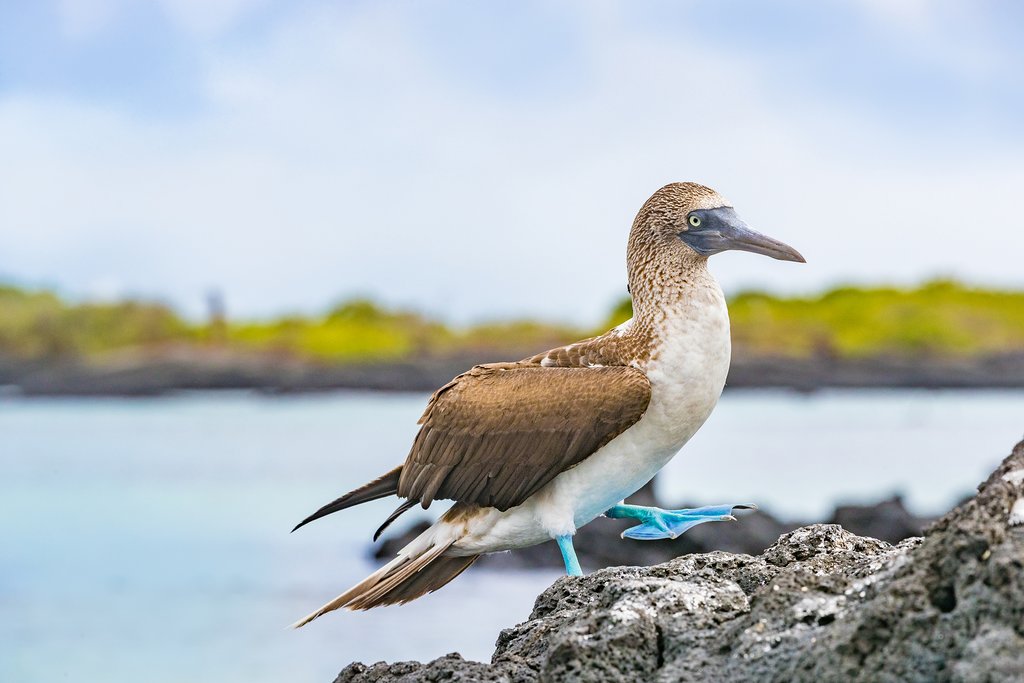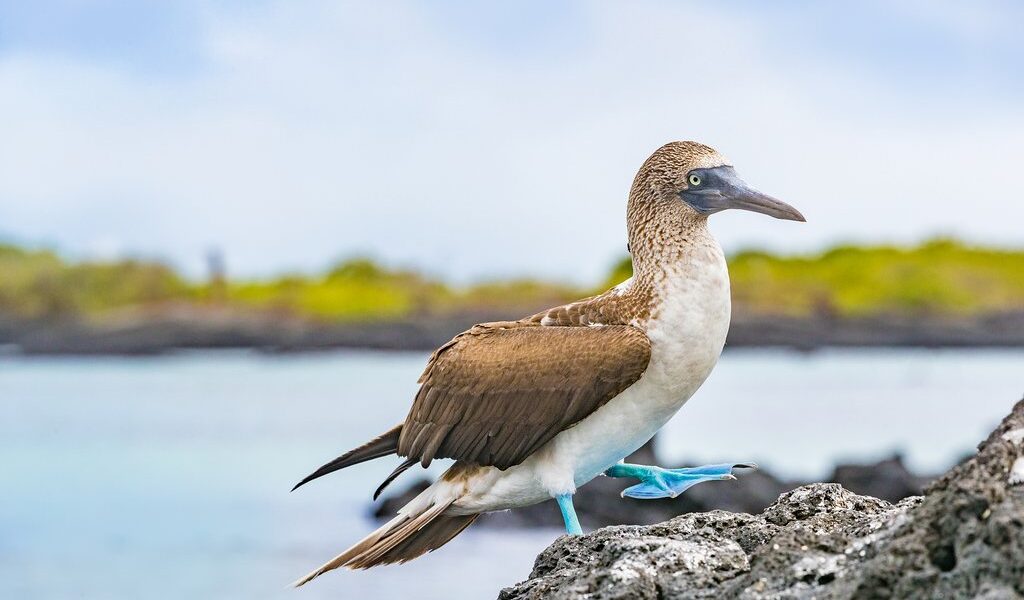
July is the middle of the high season in the Galápagos, with many international and Ecuadorian families traveling to the islands during this time. Visitors during this month will enjoy colder waters, abundant marine life, and incredible birdwatching. It is the perfect time to travel with family, enjoy hiking, dive with sharks and whales, and go snorkeling among crustaceans and mollusks. Lazy sea lions and their pups will welcome you around the islands, and you will see blue-footed boobies go about their days. Keep reading for travel advice for visiting the Galápagos in July.
The Galápagos Islands in July offer a unique and unforgettable travel experience. The weather in July presents a pleasant environment, marked by cooler waters and a slight reduction in air temperature. July falls squarely within the Galápagos Islands’ dry season, a period also affectionately known as the *garúa*. Often cited as one of the “coldest” months within the archipelago, it paradoxically provides an excellent opportunity for exploration, particularly when it comes to hiking and observing the islands’ diverse wildlife on land. Importantly, the water temperature remains inviting, making it suitable for swimming and snorkeling activities.
During this time, travelers can anticipate daily temperatures hovering around a comfortable 68 °F. The water temperatures are equally appealing, typically settling around 72 °F. Rainfall is infrequent during July, contributing to the pleasant conditions. Instead, visitors can expect to encounter stronger currents and more frequent cloud cover. This period is ideally suited for travelers seeking an active vacation while concurrently avoiding excessively hot and humid climates that can sometimes characterize other tropical destinations.
It’s worth noting that the sea conditions in July tend to be a bit rougher compared to other times of the year. If you are considering embarking on a boat tour, it is important to factor in the increased motion that may occur on the water. You might also notice stronger winds, though these are generally considered mild when compared to other popular travel destinations, such as those found in the Caribbean. Packing some warmer clothing is advisable, as temperatures tend to drop during the evenings and at night. A wind jacket can prove particularly useful, especially when taking boat rides across the often brisk waters.
The month of July stands as a peak travel period for the Galápagos Islands, attracting visitors from all corners of the globe. This surge in tourism is partially attributed to the fact that July coincides with school holidays in many countries, making it a popular time for family vacations. Furthermore, the marine life is known to be particularly vibrant and active during this time, drawing adventurous travelers and enthusiasts of water-based activities like surfing and diving. Given the high demand, island cruises tend to book up quickly, particularly those that incorporate popular activities such as snorkeling and diving.
Therefore, it is strongly recommended to book boat tours well in advance of your trip, ideally weeks or even months ahead of your intended travel dates. The popularity of July also results in increased costs for both activities and flights. However, with careful planning and early bookings, it is still possible to secure good deals on hotel accommodations. Land-based tours are generally a bit easier to book upon arrival, but pre-booking is still a recommended precaution to avoid disappointment. Overall, July is considered one of the most enjoyable and action-packed months to experience the Galápagos Islands, offering a plethora of opportunities for exploration and adventure.
When considering where to go within the Galápagos Islands in July, you’ll find an environment teeming with wildlife. Many bird species are in the midst of breeding and nesting during this period, creating unparalleled opportunities for birdwatching. The abundance of wildlife is truly remarkable, with a diverse range of species exhibiting heightened activity both above and below the water’s surface. For those eager to encounter whale sharks, a trip to the coasts of **Wolf** and **Darwin Island** is highly recommended. Alternatively, a cruise to the south and west of **Isabela Island** offers some of the best opportunities for dolphin and whale sightings.
On **Fernandina Island**, flightless cormorants engage in their courtship rituals and nesting activities, providing a unique spectacle for observers. Meanwhile, **Española Island** becomes populated with the iconic blue-footed boobies as they participate in their own elaborate courting displays. Throughout **Española Island**, you will likely observe booby eggs, juveniles, and young adults, offering a comprehensive glimpse into their life cycle. Both **Fernandina Island** and **Española Island** provide excellent snorkeling opportunities, with nutrient-rich waters supporting a thriving population of crustaceans and mollusks.
The Galápagos penguins and greater flamingos are also breeding and nesting during this time of year. You can primarily observe these species on Bartolome, **Fernandina**, and **Isabela Island**. July marks the beginning of the lava lizards’ courtship season, and they can be found in abundance on nearly all of the islands, with the exceptions of **Genovesa**, **Darwin**, and **Wolf Island**. These fascinating creatures possess remarkable camouflage abilities, and even employ a defensive tactic of dropping their tail should they be captured by a predator. **Santa Cruz Island** is renowned as a prime location to observe giant tortoises in their natural habitat. Meanwhile, the charming baby sea lions on **San Cristobal Island** are sure to capture the hearts of visitors.
Despite the somewhat reduced water clarity that can occur during the *guará* season, July actually offers better underwater visibility than many other months. The cooler weather conditions make it an ideal time for hiking and walking expeditions around the islands. Engaging in other land-based activities, such as a visit to the esteemed **Charles Darwin Research Station**, is also highly recommended. Birdwatchers will find the Galápagos Islands to be particularly rewarding during this period, but the unique avian species are sure to captivate the interest of almost any visitor, regardless of their prior interest in ornithology.
The increased activity of marine life during July significantly enhances the chances of spotting whales. Even snorkeling conditions remain quite favorable during this month. It is also the prime time to observe humpback whales and various species of sharks. Seize the opportunity to dive with these incredible creatures in their natural environment. Galápagos sea lions are particularly abundant as they tend to breed during this time, and they are noticeably more active around the islands.
A visit to the **Laguna Concha y Perla (Shell and Pearl Lagoon)** is highly recommended, particularly for those seeking a safe and accessible location for practicing snorkeling, especially children. Upon arrival at the docking port, you’ll encounter a wooden walkway that is often populated by resting sea lions. Continue along this walkway to reach the picturesque small lagoon, where you might be fortunate enough to spot manta rays, tropical fish, penguins, sea lions, sea turtles, and even white tip reef sharks.
Regarding events in July, the **Fundación de Guayaquil—Founder’s Day (July 25)** is a significant occasion. This national holiday is primarily celebrated in **Guayaquil**, where the city traditionally dedicates two days to festivities. Given its close proximity and the relatively short 2-hour flight, many locals from **Guayaquil** choose to travel to the Galápagos Islands during this holiday period, sometimes extending their visit into a longer vacation.
B-889

